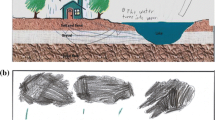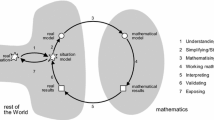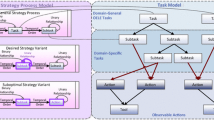Abstract
Chemistry knowledge can be represented at macro-, micro- and symbolic levels, and learning a chemistry topic requires students to engage in multiple representational activities. This study focused on scaffolding for inter-level connection-making in learning chemistry knowledge with graphical simulations. We also tested whether different sequences of representational activities produced different student learning outcomes in learning a chemistry topic. A sample of 129 seventh graders participated in this study. In a simulation-based environment, participants completed three representational activities to learn several ideal gas law concepts. We conducted a 2 × 3 factorial design experiment. We compared two scaffolding conditions: (1) the inter-level scaffolding condition in which participants received inter-level questions and experienced the dynamic link function in the simulation-based environment and (2) the intra-level scaffolding condition in which participants received intra-level questions and did not experience the dynamic link function. We also compared three different sequences of representational activities: macro-symbolic-micro, micro-symbolic-macro and symbolic-micro-macro. For the scaffolding variable, we found that the inter-level scaffolding condition produced significantly better performance in both knowledge comprehension and application, compared to the intra-level scaffolding condition. For the sequence variable, we found that the macro-symbolic-micro sequence produced significantly better knowledge comprehension performance than the other two sequences; however, it did not benefit knowledge application performance. There was a trend that the treatment group who experienced inter-level scaffolding and the micro-symbolic-macro sequence achieved the best knowledge application performance.





Similar content being viewed by others
Notes
This simulation-based environment includes three phenomenon simulations that illustrate three gas phenomena corresponding to the three laws (the Gay-Lussac's law, the Boyle’s law and the Charles’ law) and one “container of molecules” simulation in which students can manipulate to learn the relationships among temperature, pressure and volume variables as well as view molecular behaviors under different conditions. In this study, students were expected to learn the temperature–pressure relationship when volume stayed constant (the Gay-Lussac's law); thus, they only learned one phenomenon simulation (i.e., “aerosol can” simulation) and the volume variable was set constant in the “container of molecules” simulation.
References
Ainsworth S (2006) DeFT: A conceptual framework for considering learning with multiple representations. Learn Instr 16(3):183–198
Ainsworth S (2008) The educational value of multiple-representations when learning complex scientific concepts. In: Gilbert J, Reiner M, Nakhleh M (eds) Visualization: theory and practice in science education, vol 3. Springer, Dordrecht, pp 191–208
Anderson LW (ed), Krathwohl DR (ed), Airasian PW, Cruikshank KA, Mayer RE, Pintrich PR, Raths J, Wittrock MC (2001) A taxonomy for learning, teaching, and assessing: A revision of Bloom’s taxonomy of educational objectives (complete edition). Longman, New York
Ardac D, Akaygun S (2004) Effectiveness of multimedia-based instruction that emphasizes molecular representations on students’ understanding of chemical change. J Res Sci Teach 41(4):317–337
Ayas A, Özmen H, Çalık M (2010) Students’ conceptions of the particulate nature of matter at secondary and tertiary level. Int J Sci Educ 8(1):165–184
Benson DL, Wittrock MC, Baur ME (1993) Students’ preconceptions of the nature of gases. J Res Sci Teach 30(6):587–597
Berthold K, Renkl A (2009) Instructional aids to support a conceptual understanding of multiple representations. J Educ Psychol 101(1):70–87
Çalik M (2013) Effect of technology-embedded scientific inquiry on senior science student teachers’ self efficacy. Eurasia J Math Sci Technol Educ 9(3):223–232
Çalik M, Ayas A (2005) A comparison of level of understanding of eight-grade students and science student teachers related to selected chemistry concepts. J Res Sci Teach 42(6):638–667
Çalik M, Kolomuc A, Karagolge Z (2010) The effect of conceptual change pedagogy on students’ conception of rate of reaction. J Sci Educ Technol 19(5):422–433
Chang H-Y, Quintana C, Krajcik JS (2010) The impact of designing and evaluating molecular animations on how well middle school students understand the particulate nature of matter. Sci Educ 94(1):73–94
Chi MTH, Wylie R (2014) The ICAP framework: linking cognitive engagement to active learning outcomes. Educ Psychol 49(4):219–243
Chi MTH, Roscoe RD, Slotta JD, Roy M, Chase CC (2012) Misconceived causal explanations for emergent processes. Cogn Sci 36(1):1–61
Chiu J, Linn M (2014) Supporting knowledge integration in chemistry with a visualization-enhanced inquiry unit. J Sci Educ Technol 23(1):37–58
Corradi D, Clarebout G, Elen J (2015) Cognitive dissonance as an instructional tool for understanding chemical representations. J Sci Educ Technol 24(5):684–695
de Vos W, Verdonk AH (1996) The particulate nature of matter in science education and in science. J Res Sci Teach 33(6):657–664
Frederiksen JR, White BY, Gutwill J (1999) Dynamic mental models in learning science: the importance of constructing derivational linkages among models. J Res Sci Teach 36(7):806–836
Gentner D, Markman AB (1997) Structure mapping in analogy and similarity. Am Psychol 52(1):45–56
Gilbert J, Treagust D (2009) Introduction: macro, submicro and symbolic representations and the relationship between them: key models in chemical education. In: Gilbert J, Treagust D (eds) Multiple representations in chemical education, vol 4. Springer, Dordrecht, pp 1–8
Goldstone RL, Son JY (2005) The transfer of scientific principles using concrete and idealized simulations. J Learn Sci 14(1):69–110. doi:10.1207/s15327809jls1401_4
Hmelo-Silver CE, Pfeffer MG (2004) Comparing expert and novice understanding of a complex system from the perspective of structures, behaviors, and functions. Cogn Sci 28(1):127–138
Hmelo-Silver CE, Marathe S, Liu L (2007) Fish swim, rocks sit, lungs breathe: expert-novice understanding of complex systems. J Learn Sci 16(3):307–331
Jaber LZ, BouJaoude S (2012) A macro–micro–symbolic teaching to promote relational understanding of chemical reactions. Int J Sci Educ 34(7):973–998
Jacobson MJ, Wilensky U (2006) Complex systems in education: scientific and educational importance and implications for the learning sciences. J Learn Sci 15(1):11–34
Johnstone AH (1982) Macro- and micro-chemistry. Sch Sci Rev 64:377–379
Johnstone AH (2000) Teaching of chemistry: logical or psychological? Chem Educ Res Pract Eur 1(1):9–15
Kautz CH, Heron PRL, Loverude ME, McDermott LC (2005) Student understanding of the ideal gas law, part I: a macroscopic perspective. Am J Phys 73(11):1055–1063
Kozma RB (2000) The use of multiple representations and the social construction of understanding in chemistry. In: Jacobson M, Kozma R (eds) Innovations in science and mathematics education: Advanced designs for technologies of learning. Erlbaum, Mahwah, pp 11–46
Kozma R (2003) The material features of multiple representations and their cognitive and social affordances for science understanding. Learn Instr 13(2):205–226
Kozma R, Russell J (2005) Students becoming chemists: developing representational competence. In: Gilbert J (ed) Visualization in science education, vol 1. Springer, Dordrecht, pp 121–145
Levy D (2013) How dynamic visualization technology can support molecular reasoning. J Sci Educ Technol 22(5):702–717
Levy S, Wilensky U (2009) Students’ learning with the connected chemistry (CC1) curriculum: navigating the complexities of the particulate world. J Sci Educ Technol 18(3):243–254
Linn MC, Davis EA, Bell P (2004) Inquiry and technology. In: Linn MC, Davis EA, Bell P (eds) Internet environments for science education. Lawrence Erlbaum Associates, Mahwah, pp 3–28
Liu L, Hmelo-Silver CE (2009) Promoting complex systems learning through the use of conceptual representations in hypermedia. J Res Sci Teach 46(9):1023–1040
Mas CJ, Perez JH, Harris H (1987) Parallels between adolescents’ conceptions of gases and the history of chemistry. J Chem Educ 64:616–618
Nakhleh MB (1992) Why some students don’t learn chemistry: chemical misconceptions. J Chem Educ 69(3):191–196
Plass J, Homer B, Hayward E (2009) Design factors for educationally effective animations and simulations. J Comput High Educ 21(1):31–61
Quintana C, Reiser BJ, Davis EA, Krajcik J, Fretz E, Duncan RG et al (2004) A scaffolding design framework for software to support science inquiry. J Learn Sci 13(3):337–386
Russell J, Kozma R, Becker D, Susskind T (2000) SMV: Chem; Synchronized multiple visualizations in chemistry. Wiley, New York
Snir J, Smith CL, Raz G (2003) Linking phenomena with competing underlying models: a software tool for introducing students to the particulate model of matter. Sci Educ 87:794–830
Stavy R (1988) Children’s conception of gas. Int J Sci Educ 10(5):553–560
Stieff M, Wilensky U (2003) Connected chemistry—incorporating interactive simulations into the chemistry classroom. J Sci Educ Technol 12(3):285–302
Taber KS (2013) Revisiting the chemistry triplet: drawing upon the nature of chemical knowledge and the psychology of learning to inform chemistry education. Chem Educ Res Pract 14(2):156–168
Treagust D, Chittleborough G, Mamiala T (2003) The role of submicroscopic and symbolic representations in chemical explanations. Int J Sci Educ 25(11):1353–1368
Tsai CC (1999) Overcoming junior high school students’ misconceptions about microscopic views of phase change: a study of an analogy activity. J Sci Educ Technol 8(1):83–91
Tsaparlis G (2009) Learning at the macro level: the role of practical work. In: Gilbert J, Treagust D (eds) Multiple representations in chemical education, vol 4. Springer, Dordrecht, pp 109–136
Ultay N, Çalik M (2016) A comparison of different teaching designs of ‘acids and bases’ subject. Eurasia J Math Sci Technol Educ 12(1):57–86
van der Meij J, de Jong T (2006) Supporting students’ learning with multiple representations in a dynamic simulation-based learning environment. Learn Instr 16(3):199–212
White R, Gunstone R (1992) Probing understanding. The Falmer Press, London
Wu H-K, Puntambekar S (2012) Pedagogical affordances of multiple external representations in scientific processes. J Sci Educ Technol 21(6):754–767
Wu H-K, Shah P (2004) Exploring visuospatial thinking in chemistry learning. Sci Educ 88(3):465–492
Wu H-K, Krajcik JS, Soloway E (2001) Promoting understanding of chemical representations: students’ use of a visualization tool in the classroom. J Res Sci Teach 38(7):821–842
Zhang ZH, Linn MC (2013) Learning from chemical visualizations: comparing generation and selection. Int J Sci Educ 35(13):2174–2197
Author information
Authors and Affiliations
Corresponding author
Appendices
Appendix 1: Sample Questions/Tasks in the Three Representational Activities
Questions in the Macro Activity
-
Slowly drag the fire holder to the bottom of the aerosol can, observe and describe what happens.
-
Think about this: Why does the aerosol can explode as you move the fire close enough?
Questions/Tasks in the Symbolic Activity
-
Slowly drag the temperature slider from left to right, record the values for temperature, pressure and volume for five times.

-
Please put the data points you recorded in the following graph

-
Discuss with your group partners: What do you learn from the data?
Sample Questions in the Micro Activity
-
Please look at one molecule. Does it move in a certain direction or in random directions?
-
How could a molecule keep changing directions?
-
Please drag the temperature slider back and forth, describe how do the gas molecules behave and interact with each other?
Appendix 2: Pre- and Posttest
Pretest |
1. An infected tooth forms a tiny space that fills with gas. The gas puts pressure on the nerve of the tooth, causing a toothache. Which of the following should the patient choose to relieve pain? |
A. Moist heat |
B. Ice pack |
Why? Explain |
2. Car tires are more likely to pop in the summer than in the winter. Please explain why that happens |
Posttest |
Comprehension subtest |
1. Gas is composed of______________ |
2. Do gas molecules move in certain directions? How do gas molecules behave? How do gas molecules interact with each other? |
3. Label the variables on the picture (In this labeling question, a snapshot of the simulation was given, and participants were expected to correctly label temperature, volume and pressure, and the three unit names for the variables) |
4. You throw an aerosol can into the fire and it explodes. Please explain how that happens. |
5. What is gas pressure? How do you understand gas pressure? |
6. When the volume of a certain amount gas stays the same, the higher the temperature, the ______________ the gas pressure. How does that happen? |
7. If you want to decrease gas pressure, what should you do? Why? |
Application subtest (same as the pretest) |
1. An infected tooth forms a tiny space that fills with gas. The gas puts pressure on the nerve of the tooth, causing a toothache. Which of the following should the patient choose to relieve pain? |
A. Moist heat |
B. Ice pack |
Why? Explain. |
2. Car tires are more likely to pop in the summer than in the winter. Please explain why that happens. |
Appendix 3: Coding and Scoring Scheme and Coding and Scoring Examples (Open-Ended Questions)
Knowledge Units in the Coding Scheme
Functional Knowledge Units
- F1:
-
Causal relationship between gas pressure and some macro-level phenomena, e.g., increased pressure caused the car tire to explode
- F2:
-
Causal relationship between temperature and pressure, e.g., lower temperature leads to lower pressure
- F3:
-
Causal relationship between temperature and speed of molecular movement, e.g., when temperature is higher, molecules move faster
- F4:
-
Causal relationship between temperature and molecular collision rate, e.g., when temperature is higher, molecules bounce off more
- F5:
-
Causal relationship between molecular behaviors and pressure as an emergent function, e.g., molecules bouncing off more causes pressure to increase
Behavior Knowledge Units
- B1:
-
Random movement of gas molecules, e.g., molecules move in random directions, molecules move all over the place
- B2:
-
Speed change of gas molecules, e.g., molecules move faster/slower
- B3:
-
Bouncing behaviors of gas molecules, e.g., molecules collide with each other, and molecules bounce off container walls
Structural Knowledge Units
- S1:
-
Mention “temperature” of gas without mentioning its relationship to gas pressure or molecular behaviors, e.g., it is about temperature
- S2:
-
Mention “molecules” without describing their behaviors or interactions, e.g., because of molecules
Coding and scoring procedure In order to increase the objectivity in scoring participants’ answers, we reviewed each answer to an open-ended question for the presence and absence of each knowledge unit listed above. We applied the codes F1, F2, F3, F4, F5, B1, B2, B3, S1, S2 if the associated knowledge units were present. To score an answer, we assigned 1 point to each functional and behavior knowledge unit and assigned 0.5 point to each structural knowledge unit. If an answer did not contain any of the knowledge units in our list, no code was assigned and the answer was scored 0.
Sample question from the comprehension subtest: Do gas molecules move in certain directions? How do gas molecules behave? How do gas molecules interact with each other? | Sample question from the comprehension subtest: You throw an aerosol can into the fire and it explodes. Please explain how that happens | Sample question from the comprehension subtest: What is gas pressure? How do you understand gas pressure? | Sample question from the application subtest: Car tires are more likely to pop in the summer than in the winter. Please explain why that happens |
|---|---|---|---|
Answer: “By behaving, I think” Code: none Score: 0 | Answer: “It happens by the can burning up as the fire moves closer to the aerosol can” Code: none Score: 0 | Answer: “Gas pressure is when you pressure the gas” Code: none Score: 0 | Answer: “Because the sun makes it explode” Code: none Score: 0 |
Answer: “Bumping into each other” Code: B3 Score: 1 | Answer: “Heat in the fire makes molecules in the can go crazy then end up exploding” Code: F3 Score: 1 | Answer: “Gas pressure is made of molecules, I don’t know the rest” Code: S2 Score: 0.5 | Answer: “They are more likely to pop in the summer because the heat of the sun would make the tire to get heated up and over inflate” Code: S1 Score: 0.5 |
Answer: “Gas molecules go random ways, gas molecules interact with each other by bumping into each other” Code: B1, B3 Score: 2 | Answer: That happens because the more something heats up the faster the molecules move so they hit the walls of the soda cans so hard and much the can exploded Code: F3, F4 Score: 2 | Answer: “Gas pressure is when the pressure in the air is heavy so the molecules movement are at full speed” Code: B2 Score: 1 | Answer: “In the summer would pop the tires, because of the temperature, if it’s hot the pressure will rise” Code: F2 Score: 1 |
Answer: They move in random directions and they bounce off each other. They move fast and slow Code: B1, B3, B2 Score: 3 | Answer: “The molecules create an impact by bumping into each other when in contact with heat, therefore creating pressure that the can can’t hold” Code: F3, F2, F5 Score: 3 | Answer: “What I know about gas pressure is that if the temperature is high the molecules moved faster, the pressure controlled the molecules” Code: F2, S2 Score: 1.5 | Answer: “Because of the molecules speeding and there is a lot of pressure on the tires so they pop” Code: B2, F1 Score: 2 |
Overall number and proportion of students who scored 0–0.5 (low-level understanding—LU), 1–1.5 (medium-level understanding—MU) and > 1.5 (high-level understanding—HU) for each item | |||||||||||
|---|---|---|---|---|---|---|---|---|---|---|---|
LU | MU | HU | LU | MU | HU | LU | MU | HU | LU | MU | HU |
N = 8 7 % | N = 36 29 % | N = 79 64 % | N = 64 52 % | N = 37 30 % | N = 22 18 % | N = 96 78 % | N = 27 22 % | N = 0 0 % | N = 69 56 % | N = 28 23 % | N = 26 21 % |
Rights and permissions
About this article
Cite this article
Li, N., Black, J.B. Inter-level Scaffolding and Sequences of Representational Activities in Teaching a Chemical System with Graphical Simulations. J Sci Educ Technol 25, 715–730 (2016). https://doi.org/10.1007/s10956-016-9626-4
Published:
Issue Date:
DOI: https://doi.org/10.1007/s10956-016-9626-4






